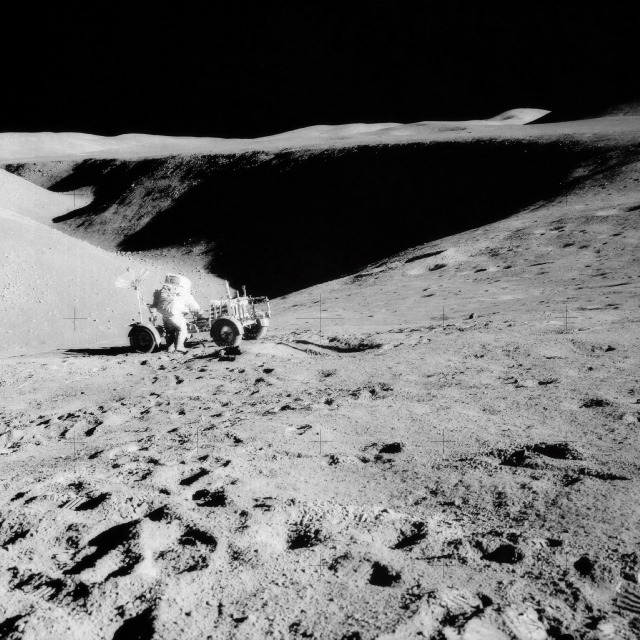
More than four decades have passed since one of the most brilliant missions ever undertaken in the annals of space science. Apollo 15, launched in July 1971, carried U.S. astronauts Dave Scott, Al Worden, and Jim Irwin to the Moon for an expansive program of research, both in lunar orbit and on the surface. Scott and Irwin spent three days exploring a place called Hadley, a small patch of Mare Imbrium at the base of the lunar Apennine Mountains—some of whose peaks rise to 4,000 feet (1,200 meters)—and a 25-mile (40-km) meandering gorge, known as Hadley Rille. To assist in their exploration, they utilized the first battery-powered Lunar Roving Vehicle (LRV). Meanwhile, Worden conducted his own scientific studies from lunar orbit and during the return journey participated in the world’s first “deep-space” EVA, more than 180,000 miles (300,000 km) from Earth. Yet Apollo 15’s EVA extravaganza also emcompassed three lengthy Moonwalks, which made one of Apollo’s grandest scientific discoveries, and the first Stand-Up EVA (SEVA) on the lunar surface.
One of the skills that Scott had learned from his scientific mentor, Professor Leon T. Silver of California Institute of Technology, was the need to gain a visual impression of the variety of the landing site that he and Irwin would explore on Apollo 15. With this in mind, Scott requested mission planners to schedule a SEVA a couple of hours after touchdown on the Moon, in which he would poke his helmeted head through the top hatch of the lunar module Falcon and photograph and describe his surroundings. Deke Slayton, head of the Flight Crew Operations Directorate (FCOD), initially opposed the idea, on the grounds that it would waste valuable oxygen, but Scott fiercely argued his case and won approval. To conduct the half-hour SEVA, Scott pulled a balaclava-like lunar excursion visor assembly over his clear bubble helmet, clambered onto the ascent engine cover and removed the top hatch. It was, he later wrote in his memoir, Two Sides of the Moon, “rather as if I was in the conning tower of a submarine or the turret of a tank.”
Meanwhile, Irwin shaded the instrument panel from the sunlight and arranged Scott’s oxygen hoses and communications cables to enable him to stand upright. “He offered me a chance to look out,” Irwin wrote in his autobiography, To Rule the Night, “but my umbilicals weren’t long enough and I didn’t want to take the time to rearrange them.” In the weak lunar gravity, Scott found that he could easily support himself in the hatch on his elbows and beheld the stunning view of the brown-and-tan Apennines, tinged by the intense blaze of golden sunlight, against the ace-of-spades blackness of the sky. Irwin passed up a bearing indicator and a large orientation map, which Scott used to shoot a couple of dozen interconnected stereo pictures of the landing site now officially known as “Hadley Base.”
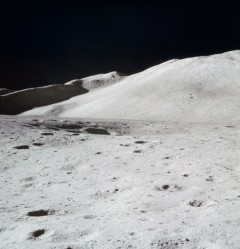
As his eyes accustomed to the view, and his mind connected it with months spent examining Lunar Orbiter maps, Scott began reeling off the recognizable landmarks. There was Pluton and Icarus and Chain and Side—intriguing craters in an area known as the “North Complex”—and on the lower slopes of Mount Hadley Delta was the vast, yawning pit of St. George Crater. One particularly prominent, rocky landmark which they had dubbed “Silver Spur,” in honor of their professor, showed clear evidence of stratigraphy in its flanks. The tops of the mountains were smooth and rounded and bore little resemblance to the forbidding, 1950s-era paintings of the Moon, which showed jagged, menacing peaks.
“The SEVA was a marvelous and useful experience, for a lot of reasons,” Scott later explained to the Apollo Lunar Surface Journal. “One of our problems at Hadley was that the resolution of the Lunar Orbiter photography was only 66 feet (20 meters), so they couldn’t prepare a detailed map. The maps we had were best guesses and we had the radar people tell us before the flight that there were boulder fields—massive boulders—all over the base of Hadley Delta, just boulders everywhere. So another reason for the Stand-Up EVA was to look and see if we could drive the Rover, because if there were boulder fields down there, and nobody could prove there were no boulder fields, it changed the whole picture.”
The view set Scott’s mind at ease; not just because it looked totally unhostile, but because it contradicted pre-flight fears. He could clearly see that despite the undulating nature of the terrain, it was surprisingly gentle, with no rocks bigger than about 6-8 inches (15-20 cm) nearby. The “trafficability,” as he put it, would be excellent. The next three days of exploration, surely, would be charmed. As he prepared to come back inside the cabin after 33 adrenaline-charged minutes, Scott was electrified. “Tell those geologists in the back room to get ready,” he breathed, “because we’ve really got something for them!”
Arguably one of the most significant events of Apollo 15 took place on their second Moonwalk, on 1 August 1971. “We’re looking now, primarily, for a wide variety of rock samples from the [Apennine] Front,” Capcom Joe Allen told the astronauts during their pre-EVA planning briefing that morning. “We think there may very well be some large crystal[line] igneous [rocks] and we’d like samples of those and whatever variety of rocks which you’re able to find for us, but primarily a large number of documented samples and fragment samples.” Scott was in full agreement; Allen was talking their language and after two years of geological training he felt ready and confident to explore.
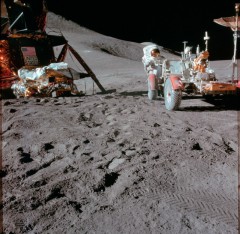
Shortly afterwards, safely buckled aboard the LRV, Scott and Irwin set off due south, heading for Mount Hadley Delta, upon whose slopes they would concentrate their energies. It was a scenic trip, Irwin recalled in To Rule the Night. Ahead of them, and all around them, the terrain was literally splattered with craters, right up the slopes of Hadley Delta, whose height rivaled the tallest peaks of the Rockies. After passing the vast cavity of Dune Crater, they started up the mountain. On the plain the going had been rough, but on the slope the surface smoothed out markedly. On reaching a point just below Spur Crater, they swung left and drove cross-slope. Looking down the slope, they were astonished to realize how far they had come. The lunar module Falcon was a tiny speck on the undulating plain, and the astronauts were now at an elevation of about 330 feet (100 meters), and the view, completely unimpaired by atmosphere or the slightest hint of haze, knocked Dave Scott’s socks off.
Their first task was to find a small “drill-hole” crater that could have excavated material from the mountain, but the flank was remarkably clean. Scott curtailed the planned drive, and they sampled a small crater and then an isolated boulder which was coated in greenish material. The green hue captivated Jim Irwin, whose Irish descent and birthday on St. Patrick’s Day—and the fact that he stowed some shamrocks in the lunar module—made this a special find. At first, the two men wondered if their eyes or Sun visors were playing tricks on them, but when it was unpacked a few weeks later in the Lunar Receiving Laboratory (LRL), their initial suspicions would be confirmed: it was green, made entirely of minuscule spheres of glass, tiny droplets of magma spewed from a fissure by a “fire fountain.” In time, it and other samples would contribute to making Apollo 15 one of the greatest voyages of discovery ever undertaken in human history.
Finally, they headed for Spur Crater, which proved to be a real gold mine of geological treasure. “As soon as we got there,” Irwin described, “we could look over and see some of this white rock. Immediately, I saw white, I saw light green and I saw brown. But there was one piece of white rock that looked different from any of the others. We didn’t rush over to it; we went about our job the usual way. First I took down-Sun shots and a locator shot about 45 degrees from the Sun-line and Dave took a couple of cross-Sun shots.”
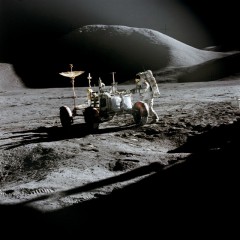
Scott and Irwin slowly threaded their way between the craters to the strange white rock that they had seen earlier. “It was lifted up on a pedestal,” Irwin wrote. “The base was a dirty old rock covered with lots of dust that sat there by itself, almost like an outstretched hand. Sitting on top of it was a white rock, almost free of dust. From four feet (1.2 meters) away, I could see unique long crystals with parallel lines, forming striations.” Scott used a pair of tongs to pick it up from its small, light-grey pedestal and held it up, close to his visor, to inspect it. The rock was about the same size as his fist and even as he lifted it, some of its dusty coating crumbled away and he saw large, white crystals.
“Aaaahh!” he exulted.
“Oh, man!” added Irwin.
The rock was almost entirely plagioclase—an important tectosilicate feldspar mineral used by petrologists on Earth to help determine the composition, origin, and evolution of igneous rocks—and from their expeditions into the hills of California’s San Gabriel Mountains, Scott instantly recognized it as a specimen of “anorthosite,” which is the purest form of plagioclase. For some time, lunar geologists had suspected that anorthosite formed the Moon’s original, primordial crust; indeed, data from the unmanned Surveyor 7 lander had suggested its presence in the ejecta of the crater Tycho, and tiny fragments of it had actually been found in samples from both Tranquility Base and the Ocean of Storms.
“Explaining why most of the Moon’s crust should be composed of anorthosite,” wrote Andrew Chaikin in his definitive account of the Apollo lunar missions, A Man on the Moon, “led some geologists to an extraordinary scenario. Within the infant satellite, they proposed, there was so much heat that the entire outer shell became an ocean of molten rock. As this ‘magma ocean’ cooled, minerals crystallized. The heavier species, including the iron- and magnesium-rich crystals, sank to the bottom. The lighter crystals, specifically, the mineral [aluminium-rich] plagioclase floated to the top.”
Recognizing the find as probably a piece of the Moon’s primordial crust, Scott could hardly contain his enthusiasm.
“Guess what we just found!” he radioed. “I think we just found what we came for!”
“Crystalline rock, huh?” said Irwin.
“Yes, sir,” replied Scott, which Capcom Joe Allen echoed in his excited, Iowan drawl.
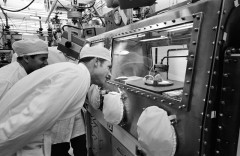
After briefly describing the rock’s appearance, Scott placed it into a sample bag by itself. It would be labeled as sample number 15415, but a keen journalist, inspired by the term petrogenesis, the study of the origin of igneous rocks, would later offer it a far more lofty title: “The Genesis Rock,” a sample of the original lunar crust, coming from one of the earliest epochs of the Moon’s history, some 4.1 billion years ago. This date was reached by geologists at the University of New York at Stony Brook and proved to be almost a billion and a half years older than the oldest rocks found on Earth. If the Moon was any older than that, noted Chaikin, it wasn’t much older; the Solar System itself was thought to have formed only a few hundred million years earlier.
Dick Gordon, Apollo 15’s backup commander, had long since described the passage of time on a spaceflight as remorseless and Scott and Irwin had little time to linger at Spur Crater. Joe Allen passed on a request from the geologists to collect a series of walnut-sized fragments, and whilst Irwin set to work with the lunar rake Scott stole a minute or two to inspect a large boulder right on the rim of the crater.
Back in the vicinity of Falcon, shortly before two in the afternoon and five hours into their second Moonwalk, Scott and Irwin had other chores to finish; first, there was the need to complete drilling a heat-flow hole which had hit resistant soil the previous day. Scott had already noticed inside the lander that his injured fingers were starting to turn black and so had to summon as much strength as he could muster—bringing his hands right up close to his chest just to squeeze the drill’s trigger—to complete the task. He could physically stand only about a minute of the pressure on his fingernails, before breaking off for a breather. At length, both sensor packages were in place to a depth of about 1.5 metres. However, when he attempted to extract the core sample he managed to lift it about eight inches (20 cm), after which it refused to budge any further. Joe Allen told him to leave it until EVA-3.
Meanwhile, Irwin had dug a trench, photographed it and used a device known as a penetrometer to test the bearing strength of its walls and floor. “If you think digging a ditch is dog’s work on Earth,” he wrote in To Rule the Night, “try digging a ditch on the Moon. The big limitation is the suit and the fact that you are clumsy at one-sixth-G. I had practised on Earth and come up with a technique that most dogs use. You spread your legs and push the dirt between them. I solved a dog’s job with a dog’s technique. This method worked perfectly on the Moon.” He easily dug through a fine grey material which he likened to talcum powder or graphite, and then a coarser, darker soil, but had to give up on reaching a very resistant layer which, although it looked moist, had all the consistency of hardpan.
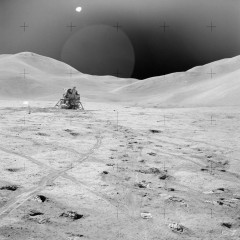
Scott and Irwin wrapped up the second Moonwalk by planting the U.S. national flag in the soil and loading that day’s rock box aboard Falcon. By the time they completed their third EVA on 2 August 1971, they had totaled 18 hours and 35 minutes on the surface, more than any previous Apollo landing crew. Furthermore, EVA-2 ran for seven hours and 12 minutes, making it the longest extravehicular activity in history at that time.
Three days later, during the return journey to Earth, the final EVA of Apollo 15 took place and secured a record as the furthest “spacewalk” ever performed from the Home Planet. Since the Service Module (SM) could not survive re-entry, it was the task of Al Worden to retrieve camera film from the Scientific Instrument Module Bay (SIMBay) on a so-called “Trans-Earth EVA,” about 180,000 miles (300,000 miles) from home. Yet, as he recounted in a May 2000 oral history interview for NASA, there were originally other methods studied for getting these films inside the command module before the agency went ahead and approved a deep-space EVA.
“There had already been some preliminary work on how to get this film out of the SIMBay,” Worden pointed out. “Of course, it had been in the pipeline for several years and there were a lot of schemes to get the film from … the back of the Scientific Instrument Module all the way up into the Command Module, [which was] a distance of about 30 feet (10 meters). How do you get out there safely so that you don’t lose it, so that you don’t hurt something? One of the schemes was … an ‘arm’ on a hinge that would go out and pick up the film and … bring it back by the hatch, where you could pick it up.” Other suggestions included an “endless clothesline,” onto which the film canisters could be hooked and reeled down the length of the Service Module to the Command Module’s crew hatch. “I objected to all of those, once we [were] assigned to the flight,” Worden recalled. “None of them were very practical. We actually proved it with the clothesline. It’s nice to think about something like an endless clothesline, but the truth was, when you’re in space, if that canister started to bounce around, there [would be] nothing to stop it.” During a test in the parabolic aircraft, it proved exceptionally difficult and potentially damaging.
In the end, it was decided that an EVA was the most effective option. By the time he set out to perform it on 5 August 1971, Worden had practised every move of the task more than 300 times aboard the parabolic aircraft. “The EVA itself was kind of unique,” Worden said of the relatively brief, 39-minute excursion, “sort of a unique perspective. I did have a chance to stand up on the outside [of the Service Module] and look. I could see the Moon and the Earth at the same time; and if you’re on Earth, you can’t do that, and if you’re on the Moon, you can’t do that! It’s a very unique place to be. I guess our biggest concern was that we had everything tied down so that when we opened the hatch, we didn’t have something go wandering off into space! But outside of that, it was pretty easy.”
Obviously, since the cabin was reduced to vacuum for the EVA, Scott and Irwin also had to don their suits. Suddenly, as soon as the hatch opened, everything that had not been properly secured began drifting around. “When we opened the hatch,” wrote Irwin, “it was just like a vacuum cleaner pulling all the loose stuff from the inside out into space. My toothbrush floated by; it had been in hiding. A camera came by; one of us grabbed it. We were all leaping around, trying to catch the important stuff.” It was Irwin’s job to move slightly outside after Worden in order to televise his EVA, but he had “goofed” when hooking up his suit’s umbilicals by wrapping them the wrong way around a strut, which limited his range of movement. “I had to force my hand out to reach the movie camera,” he wrote in To Rule the Night, “attached to a boom, to turn it on. I saw the green light and thought the camera was on, but it wasn’t working.”
Since they were so far from Earth, the experiences of both men were quite distinct from “traditional” spacewalks in orbit around the Home Planet. They were surrounded by pitch blackness, and one of the few sources of light was sunlight reflecting off the surfaces of the service module. Irwin considered it strange and eerie from his perch just inside the Command Module’s hatch, in silhouette against the full disk of the Moon. “The National Geographic did a painting of me,” he wrote. “It almost looks like a photo.” It is a pity that real photographs of what must have been an absolutely stunning event were never returned.
This is part of a series of articles to commemorate 50 years of U.S. Extravehicular Activity. Tomorrow’s article will focus on the epochal EVA of Neil Armstrong and Buzz Aldrin on the Moon during Apollo 11 in July 1969.
Want to keep up-to-date with all things space? Be sure to “Like” AmericaSpace on Facebook and follow us on Twitter: @AmericaSpace
Missions » US EVAs »



When reading Ben’s article on the Apollo 15 EVA, it is with total awe that we as human beings can read and experience such descriptions from the surface of another world. It gets more amazing as time passes. Looking forward to tomorrow’s article. Continued excellent work, Ben!